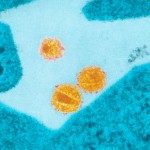Lien vers Pubmed [PMID] – 7916061
J. Virol. 1994 Oct;68(10):6634-43
To investigate the dynamics of spread of simian immunodeficiency virus (SIV) in the lymphoid organs, we sequentially analyzed the viral burden in lymph nodes (LN) of eight rhesus macaques inoculated intravenously with a high or low dose of the pathogenic SIVmac 251 isolate. For each animal, four axillary or inguinal LN were collected during the first weeks of infection and a fifth LN was taken 6 or 8 months later to estimate disease progression. Measurement of SIV RNA by in situ hybridization showed that all of the macaques studied had a phase of acute viral replication in LN between 7 and 14 days postinoculation which paralleled that observed in the blood. In a second phase, productive infection was controlled and viral particles were trapped in the germinal centers that developed in LN. While the peaks of productive infection were similar for the eight animals, marked differences in the numbers of productively infected cells that persisted in LN after primary infection were seen. Differences were less pronounced in the blood, where productive infection was efficiently controlled in all cases. The persistence of productively infected cells in LN after primary infection was found to be associated with more rapid disease progression, as measured by the decrease of the T4/T8 ratio and the occurrence of clinical signs. However, the persistence of a significant level of viral particles in germinal centers was observed even in animals that remained healthy over a 1- to 2-year observation period. This study indicates that the course of primary SIV infection in LN is variable, and it suggests that the initial capacity of the host to control productive infection in LN may determine the rate of disease progression.
